譯介:Chris Bell 面向友情的設計 Designing For Friendship
我希望推薦並翻譯的是遊戲設計師Chris Bell 2012年的GDC分享《Designing For Friendship》的全文,他從個人經歷出發,我們能十分清晰地看到他對自身經歷的思考與在遊戲設計中的實踐。
他所談論的《Journey 風之旅人》和《WAY》中的匿名性,以及陌生人之間前語言式的建立聯絡的方式是共通並且有效的,而這在人與人信任崩塌,社會日益原子化而建起藩籬的今天顯得額外珍貴。
誠然,這種電子遊戲的買斷特性,以及反向的篩選機制使得社群氛圍是更好的,但是這樣的設計實驗被證明是有效的。

我們也能看到在那之後,使用了言語文字,但同時保持了匿名性的晚近的獨立遊戲《Kind Words》是如何製作出電子遊戲式的善意漂流瓶的,而陳星漢也繼續在《Sky 光遇》中繼續做更大範圍,更多人之間的新的且包括商業化的嘗試,更別提最近的《雙人成行 It takes two》也在雙人合作的玩法上做了集大成式的探索與呈現。而我也期待電子遊戲在人與人之間的誤會消除,重建前語言的溝通和善意上能做得更多。
這是我認為這篇演講值得一讀的原因。
Chris Bell 是一位遊戲設計師,在參與《風之旅人》開發之前,他學生時代的參與設計的遊戲作品《WAY》拿到了2012年Game For Change的年度遊戲,以及當年IGF的學生組大獎,以及NUOVO獎的Finalist,隨後他參與了《艾迪芬奇的回憶 What Remains of Edith Finch》和《Sky 光遇》等情感敘事向大作的開發,現在則在一個名為Gardens的遊戲工作室試圖開發一款新的聯網奇幻冒險遊戲。可見其個人網站 https://chrisbelldesign.com/
作者:Chris Bell
翻譯:DeepL
校對潤色、幻燈片翻譯、圖片補充:葉梓濤
原文可見:https://chrisbelldesign.com/Designing-For-Friendship
原作者已授權
Designing For Friendship
面向友情的設計
Shaping Player Relationships With Rules & Freedom
通過規則-自由來塑造玩家的關係
(This is a transcript of the original talk given at the 2012 Game Developer's Conference)
這是在2012年GDC遊戲開發者大會上演講的文字記錄

"I studied abroad in Japan 4 years ago.
"4年前我在日本留學。
It was my first morning there and I was at the Tsukiji Fish Market searching for inspiration for some collage work that I was creating for a gallery show. Tsukiji is the largest wholesale fish market in the world. There are about 1000 vendors, each selling live fish just as it comes in off the boats. Fish of every color and shape. Some were familar, but I was especially fascinated by the ones that seemed alien.
在那裡的第一個早晨,我在東京築地魚市場為當時正為畫廊展覽創作的拼貼作品尋找靈感。築地是世界上最大的魚類批發市場。這裡有大約1000個商販,每個人都在銷售剛從船上運來的活魚。各種顏色和形狀的魚都有。有些我們很熟悉,但我卻特別著迷於那些看起來特別怪異的。

It was incredibly immersive—so much so that I lost all sense of time and place.
這令我沉浸,忘記了時間和地點。
Earlier that day, my professors, classmates, and I passed by a nearby shrine and chose it as our rendezvous point. At a very specific time, a bus was going to show up and we would depart. The bus was on a schedule, and so we couldn’t be late.
那天早些時候,我的教授、同學和我路過附近的一個神社,我們將它作為集合點。在某個具體的時間點,將會有一輛公交接我們離開。公交車是有時間表的,所以我們不能遲到。
When I finally pulled myself away from the fish, I realized that that time was only a few minutes away.
當我終於從對那些魚的沉浸中反映過來時,集合時間只剩下幾分鐘了。
My first morning in Japan...No phone... a few words of Japanese...I didn’t even know the name of the hotel we were staying at. I was about to be stranded with very little means to get me home.
這是我在日本的第一個早晨......沒有電話......只會幾句日語......我甚至不知道我們所住的酒店名字。我將會被困在這裡,很難能夠回到家中。
I began to panic.
我開始緊張了起來。
Fortunately, I had taken a photograph of the shrine—and so I pulled out my camera and called out to the closest person to me. I said “Sumimasen”, one of the only words of Japanese I knew, which means “Excuse me!”.
幸運的是,我拍了一張神社的照片,所以我掏出相機,向離我最近的人呼喊。我說 "Sumimasen",這是我僅會的幾個日語單詞之一,意思是 "打擾了!"。
That person happened to be a woman, about 60 or so years old, speaking to a man in a truck. Upon hearing me she turned, and I pointed to the display and threw my hands up as if to question “Where is this?”. She immediately ended her conversation, grabbed my hand and took off running. We ran about four blocks to the shrine, just as my classmates were boarding the bus to leave. She bowed, smiled, and disappeared forever.
那個人是個60歲左右的女性,正和一個卡車上的男人說話。聽到了我的話後,她轉過身來,我指著螢幕,舉起雙手,似乎在問:"這是哪裡?"。她立即結束了談話,抓住我的手就跑了起來。我們跑了大約四個街區到了神社,當時我的同學們正登上巴士準備離開。她鞠了一躬,微笑著,然後消失了,我們再也沒見過。

Now, this event took place in the infinitely complex system we call reality.
現在,這個事件發生在我們稱之為「現實」的無限複雜的系統中。
To recreate it and find meaning, as designers we have to focus in and choose the parts relevant to the scope of my perspective and my narrative as a player, and the woman’s perspective and her narrative as a player.
為了重新創造它並找到意義,作為設計師,我們必須集中精力,選擇與我的視角和我作為玩家的敘述範圍相關的部分,以及那個女人的視角和她作為玩家的敘述。
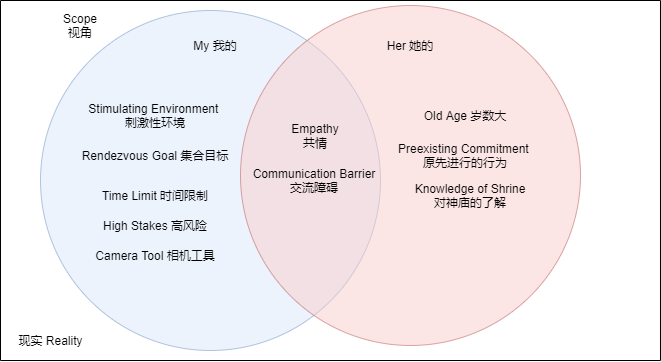
And so we pick out factors like the stimulating environment that led to me feeling overwhelmed, my goal of getting to the rendezvous point, the amount of time before the bus leaves, the high stakes of getting left behind, the distance of the shrine, the camera with the picture of the shrine which served as my only available tool...
我們挑出了一些因素,如令我感到不知所措的刺激性環境,到達集合點的目標,離巴士出發剩餘的時間,被落下的高風險,神社的距離,作為我唯一可用的工具的帶有神社照片的相機。
...and because its multiplayer, we simultaneously need to be doing the same for the woman. Her old age, her investment in her conversation, her knowledge of where the shrine was.
...因為是多人遊戲,我們同時需要為這個女人做同樣的分析。她的年齡,她對她的談話的投資,她對神社位置的瞭解。
And then there’s the relationship between us, the communication barrier that separates us, and the empathy that allows us to understand each other in spite of that.
然後是我們之間的關係,分割我們的溝通障礙,以及儘管如此,我們仍能相互理解的共情。
All of these relate to create a dynamic that leads to players feeling what we want. And then we have to take a deep breath, sit back, and give them the freedom to act.
所有這些相互關聯並創造一種動態,使得玩家能感受到我們想要讓他們感受的東西。然後我們就得深呼吸一口,坐好,給他們行動的自由。
【譯註:這裡指的更多是不通過強行設計流程並強幹預玩家之間的關係,而是預設了初始條件並且讓玩家之間自然進行互動】
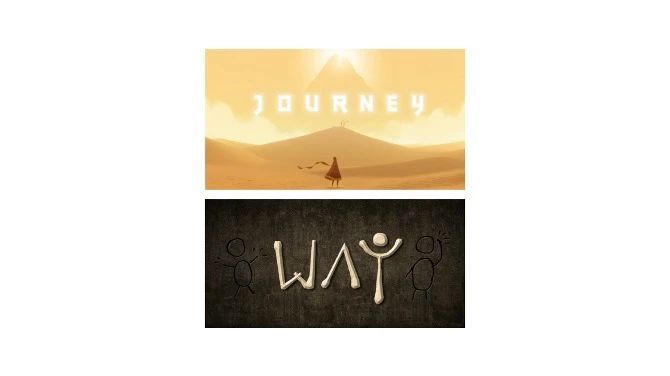
Both games I’ve helped design, "Journey" and "WAY", attempt to herd two strangers toward friendship. And both do it in similar and different ways.
我幫助設計的兩個遊戲,《風之旅人 Journey》 和 《WAY》,都試圖把兩個陌生人引向友誼。兩者都以某種類似但有差異的方式做到了這一點。
But how do we do that? How do we design so friendship will emerge? And what is friendship really?
我們是如何做到的?如何設計才能使得友誼湧現?什麼是真正的友誼?
It’s impossible to completely define or quantify. Nor can it be forced between players. Their emotional connection has to happen as a spontaneous creation of the participants.
它是不可能被完全定義或量化的。它也不可能在玩家之間被強迫。這種情感連線必須作為一種參與者的自發創造而發生。
So what type of friendship am I speaking about?
那麼,我想說是什麼型別的友誼呢?
What I’m interested in, is that spontaneous bond between strangers. I want to focus on online multiplayer that emphasizes shared goals, freedom of choice, anonymity, vulnerability, and communication.
我感興趣的是,陌生人之間那種自發的聯絡。我想把重點放在強調共同目標(Shared Goals)、自由選擇(Freedom of Choice)、匿名(Anonymity)、脆弱性(vulnerability)和溝通(Communication)的線上多人遊戲上。

Online Multiplayer provides an incredible opportunity for people around the world to play together, exempt of prejudices or stereotypes. If we can get two people to have a connection in a game, before their prejudices get in the way, then perhaps we can challenge those prejudices. Get the two people to empathize before they draw lines between each other.
線上多人遊戲(Online Multiplayer【譯註:這裡說的更多是聯網的,可多人遊玩的遊戲,該定義囊括了通常所說的 MMO 大型多人線上Massive Multiplayer Online Game,諸如Journey 和 WAY都只是兩人同時進行的】)提供了一個絕好的可能,使得世界各地的人們能夠一同遊戲,免除偏見或刻板印象。如果我們能讓兩個人在遊戲中產生聯絡,在他們受到偏見的阻礙之前,那麼我們也許可以挑戰這些偏見。讓兩個人在彼此之間劃清界限之前產生共情。
Play is a language all humans speak—it’s fundamental, universal, neurobiological, it’s how we’re wired—and so we can use play to build an understanding between people around the world.
遊戲是所有人類的語言——它是基礎性的、普遍的、神經生物學意義上的,它是我們的相互連線的方式,因此我們可以利用遊戲在世界各地的人之間建立某種理解。
Because of this potential, I’m advocating that we treat Play with all the seriousness it deserves. A lack of seriousness can lead to oversight, misuse or abuse...and so we need to put care into our designs to ensure players are acting in the ways we value. And value is obviously subjective to the designer.
正是因為這種潛力,我主張我們應以嚴肅態度對待遊戲,這本就是其應得的。缺少嚴肅性會導致疏忽、誤用或濫用......因此我們需要在我們的設計中謹慎行事,以確保玩家以我們所認同的方式行事。而這種認同的價值顯然是來自設計師的主觀。
So I just recounted a story about spontaneous face-to-face interaction... Well let’s take that face-to-face interaction and add a few different rules. By rules I mean all the things we put into our games to define the space. Instead of being face-to-face in the same physical space, we’re connected over the internet by cameras—randomly—each of us in our own home.
我剛剛講述了一個關於自發的面對面的互動的故事... 好吧,讓我們把這種面對面的互動,加上一些有些不同的規則。這裡我所說的規則是指「我們在遊戲中定義空間的所有東西」。我們不再是在同一個物理空間裡面對面,而是通過攝像機--隨機地--我們每個人都在自己的家裡通過網際網路連線。

Chat Roulette is an amazing story. What could have been an incredible portal to engage and empathize with people around the world was instead used for other things. I’m sure we all know what those were.
《聊天輪盤》是一個驚人的例子。本可以成為與世界各地的人接觸和共情的一個絕佳的視窗,但卻被用來做其他事情。我相信我們都知道那些是什麼。
【譯註:Chatroulette是一個隨機視訊聊天網站,你可以和一個隨機選出來的人進行視訊聊天或者是語音聊天,網站不需要使用者名稱和密碼,在唯一的頁面上有顯示聊天物件視訊的黑框、有輸入文字內容的白色對話方塊。你只要用滑鼠輕輕點選,就可以與網路隨機抽取的陌生網友視訊聊天,若不滿意,你只要點選“NEXT”,就可以換一位聊天物件】
Now, why did this happen?
現在,為什麼會發生這種情況?

In Chat Roulette, players are behind a screen without any rules to guide their behavior. Without rules, and secured in privacy, problematic players were able pervert the space and claim control, forcing others out.
在《聊天輪盤》中,玩家在螢幕後面,沒有任何規則來引導他們的行為。沒有規則,並且在隱私得到保障的情況下,那些有問題的玩家會敗壞這個空間,並且要求控制,迫使其他人離開。
Now compare that to the London, New York Telectroscope.
我們將其與在倫敦、紐約的電鏡進行比較。

Designed by Paul St. George for the Brooklyn Bridge’s 25th Anniversary, the Telectroscope was a 2-way camera linking London and New York, themed as a giant tunnel burrowing through the Earth. Unlike the crude interface of Chat Roulette—the Telectroscope is a spectacle—a work of art. There’s an immediate, aesthetic beauty. And so when persons interact with it, they treat it with a greater deal of respect.
電鏡是由保羅-聖喬治為布魯克林大橋25週年紀念而設計,電鏡是一個連線倫敦和紐約的雙向攝像機,主題是在地球上鑽出的一條巨大隧道。與《聊天輪盤》的粗糙介面不同,《電鏡》是一個景觀——一件藝術作品。那裡有某種直接的、審美的美感。因此當人們與它互動時,他們會以更大的尊重來對待它。

More importantly, it’s in public—players, if we may call them that, interact with one another knowing they will be seen by more than just their counterpart. Or in other words, they’re operating within the rules enforced by a public system, which have understood behavioral codes that are not regulated in Chat Roulette.
更重要的是,這是在公共場合——玩家(如果我們可以這樣稱呼他們)彼此互動,知道他們將被更多的人看到,而不僅僅是對面的人。換句話說,他們是在公共系統執行的規則內來使用電鏡的,而公共系統有明白的行為準則,而《聊天輪盤》中則沒有。
On top of that, the designer adds another restriction—no voice communication. And so players create their own playful ways to engage each other and it becomes a toy.
在此規則基礎上,設計者增加了一個限制--不能進行語音交流。就這樣,玩家們創造了他們自己有趣的方式來和對方互動,使得電鏡本身也就成了一個玩具。

The chance for abuse in the manner of Chat Roulette, well, we can’t call it zero, but I’m fairly certain you’re going to be arrested if you try.
以《聊天輪盤》式的方式來濫用電鏡的機會,不能說絕不存在,但我相當肯定,如果你嘗試,你會被抓起來。
Seeing how just those few additional rules affected player behavior—let’s go one level deeper, playing behind digital avatars in an online game.
看到了這些額外的規則是如何影響玩家行為之後--讓我們再深入一層,去看那些在網路遊戲的數字化身後的遊玩行為。

My first experience playing an MMO was in 2002. I was 16 and the game was Final Fantasy XI. Like the Fish Market story earlier, when I entered Final Fantasy I was surrounded by all sorts of information I couldn’t understand. I wandered outside of town, where I saw a Mountain. I approached the mountain—and at the base, I met up with another player and we started fighting monsters together. And then we died...
我第一次玩MMO(MMO 大型多人線上Massive Multiplayer Online Game)的經歷是在2002年。當時我16歲,遊戲是《最終幻想11》。就像之前魚市的故事一樣,當我進入《最終幻想》時,我被各種我無法理解的資訊包圍。我在城外徘徊,在那裡我看到了一座山。我走近那座山,在山腳下,我遇到了另一個玩家,我們開始一起打怪物。然後我們就死了...
When we died, a prompt appeared on my screen which read “You can wait to be revived, or you can click to teleport and return to your Home Point.” accompanied by a timer counting down toward Zero. This was my first time dying, so I didn’t know what that meant.
當我們死亡時,我的螢幕上出現了一個提示:"你可以等待被複活,或者你可以點選傳送,回到家園點。" 伴隨著一個逐漸歸零的計時器。這是我第一次死亡,所以我不知道這些是什麼意思。
Where’s my home point?
我的家園點在哪裡?
Is that where I started?
那是我開始遊戲的地方嗎?
Is my buddy’s home point the same as mine?
我的夥伴的家園點和我的一樣嗎?
If I clicked the button, would we stay together?
如果我按下按鈕,我們還會在一起嗎?
What happened when the timer reached zero?
計時器到了零的時候會發生什麼?
None of this was explained by the game. And so again I’m nervous. I quickly typed to my buddy “What should we do?”. But the response didn’t come from him, it came from the game:
這些都沒有在遊戲中得到解釋。於是我再次緊張起來。我迅速向我的夥伴打字:"我們應該怎麼做?"。但得到的回應不是來自他的,而是來自遊戲:
“You are not allowed to type when dead”.
"死亡狀態下不允許打字"。
Here I was, my corpse laid out next to his, and we couldn’t communicate. And then something phenomenal happened. I realized that if I was here, at my corpse, and my buddy’s corpse is still there, than he must still be there too.
我在這裡,我的屍體躺在他的旁邊,而我們無法溝通。這個時候,我有了一種不可思議的感受:我意識到,如果我在這裡,在我的屍體旁,而我朋友的屍體還在那裡,那麼他也一定還在那裡。
I suddenly felt more aware that there was a person behind that avatar than ever before.
我突然比以往任何時候都更清楚地意識到,在那個遊戲化身avatar背後有一個人。
A human being.
一個活生生的人(human-being)。
I could see him sitting at his computer, staring at my corpse, waiting for me as I was waiting for him. We were having a conversation without any actions at all.
我可以看到他坐在電腦前,盯著我的屍體,等待著我,就像我在等待他一樣。我們在沒有任何行動的情況下進行著對話。
Now, it’s worth pointing out that this was all totally in my head. For all I know, he could have been away heating up a Hot Pocket knowing he had 8 minutes to spare, but that’s not what I felt .
當然,這一切完全是我的想象。據我所知,他完全可能會已經離開了,並且有8分鐘時間足夠加熱一個Hot Pocket,但這並不是我的感覺。
【譯註:Hot Pockets是美國品牌的微波周轉食品,通常包含一種或多種型別的乳酪,肉或蔬菜。】
Just as the counter neared Zero, my anxiety growing, a White Mage appeared out of nowhere and revived both of us.
計數器逐漸接近零,而我的焦慮感也越來越強,一個白袍法師不知從哪裡冒出來,把我們倆都復活了。
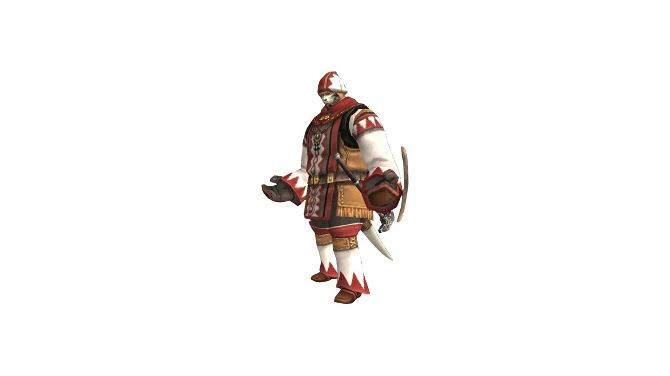
My voice returned, I sprang up and thanked the mage. This time my response did come from the player, but instead of a “You’re Welcome”, it was a single character of Kanji and a question mark.
我能夠說話了,我猛地站起來,向法師表示感謝。這一次我的回應確實來自玩家,但不是 "你太客氣了",而是一個日式漢字和一個問號。
When we realized we couldn’t speak to each other, the Mage began using the in-game gesture system to communicate. I wasn’t even aware yet that there was such a thing, and so now the Mage was teaching me, building on top of the positive relationship we already established.
當我們意識到我們無法與對方交談時,法師開始使用遊戲中的手勢系統進行交流。我甚至還不知道有這種東西,所以現在是法師在我們之間已建立的積極關係的基礎上在教導我。
Over the next couple of years, I would wave to that Japanese Mage whenever we crossed paths. Unfortunately, that was not the case with many other Japanese players, and I’ll explain why.
在接下來的幾年裡,只要我們見面,我就會向那位日本法師揮手致意。不幸的是,其他許多日本玩家卻不是這樣,我將解釋其中原因。

In Final Fantasy XI, all of the things that are valued—obtaining new armor, earning new abilities, fighting new monsters, even seeing the world—each of these is predicated on the need to Level Up. Well, leveling up meant obtaining lots of Experience Points...... and experience points were obtained through Combat.
在《最終幻想11》中,所有被重視的東西--獲得新的盔甲,獲得新的能力,與新的怪物戰鬥,甚至只是看到更大世界--每一項都是以等級提升為前提的。好吧,提升等級意味著要獲得大量的經驗值......而經驗值是通過戰鬥獲得的。
If you died, you lost Experience Points, and so Combat was important. In order to get the most Experience Points, you needed to partake in Team Combat to kill monsters stronger than yourself.
如果你死了,你就會失去經驗值,所以戰鬥很重要。為了獲得最多的經驗值,你需要參與團隊戰鬥,合作來殺死比自己更強的怪物。
In order to perform good Team Combat, you needed to know how to link moves with your teammates—You do a move....then I do a move...and those moves combine to perform a super move. In order to coordinate these moves, we had to Communicate.
為了進行良好的團隊作戰,你需要知道如何與你的隊友協作:你進行一步....,然後我也進行一步......這些動作結合起來就可以完成一個超級動作。為了協調這些動作,我們必須進行溝通。
More specifically, we had to communicate through Text.
更具體地說,我們必須通過通過文字語言進行溝通。
And so it became difficult to succeed with the Japanese players. And so you’d see this...
因此,與日本玩家一起成功變得很困難。你會看到這個...
Looking for members(Japanese Only)
招募隊友(僅限日語)
and this... Looking for members(English Only)
招募隊友(僅限英文)
Soon enough the entire world was segregated into English and Japanese-speaking players— all because the best way to achieve Experience Points relied on strong textual communication. It’s not that players didn’t want to play together. Of course they did! It’s that the design discouraged it. It didn’t have value in the game world. Certainly not if you wanted to get those precious Experience Points.
很快,整個世界就被隔離成講英語和講日語的玩家--這都是因為獲得經驗值的最佳方式依賴於強大的文字交流。這並不是說玩家不願意一起玩。他們當然想!這是因為設計上不鼓勵這樣做。它在遊戲世界中沒有價值。特別是當你想得到那些寶貴的經驗值的時候。
And so it went unconsidered.
所以這是被忽視的。
"Oh that’s just how you play the game."
"這就是你玩遊戲的方式。"
As a player I felt alienated, unwanted, disconnected... Because that was my experience. As a player, I only knew how I felt. I was not able to see the root of the problem which was occurring because something may have gone unconsidered or undervalued in the design.
作為一個玩家,我感到被疏遠......不受歡迎......脫節......。因為這就是我經歷過的事。作為玩家,我只能知道我的感覺。我無法看到問題的根源——因有些東西在設計中沒有被考慮到,或著這些東西被低估了。
A single rule or value can pollute an entire system.
一個單一的規則或價值可以汙染整個系統。
But what was it that got me so hooked in the first place? What were the seeds of my connections?
但是最初的時候是什麼讓我如此著迷?我的這些聯絡的來源於什麼?
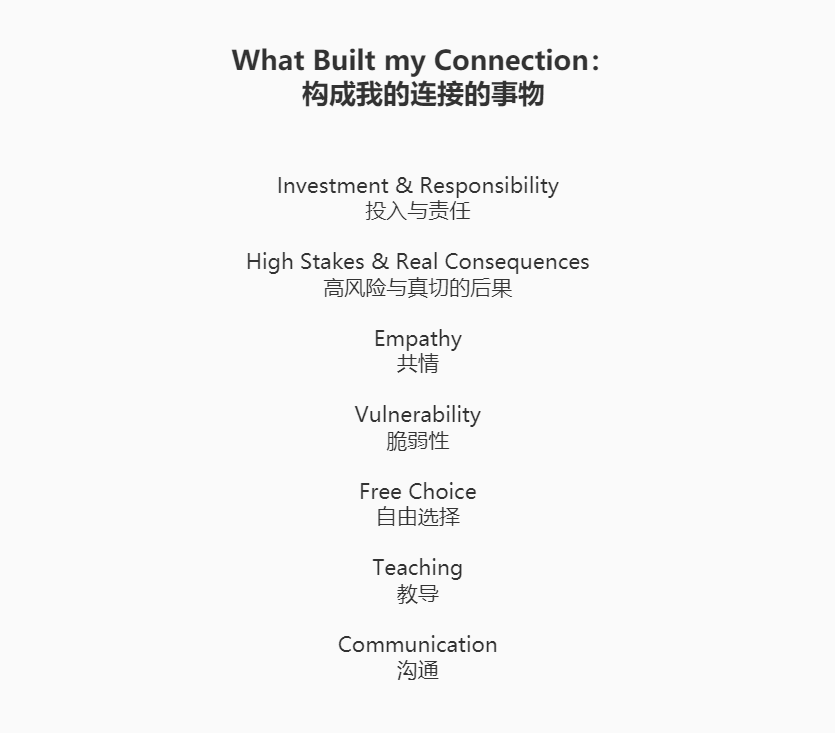
There was investment...I had made it to the Mountain and met up with a partner... There were serious consequences...we died and were about to be separated, possibly forever... There was empathy...myself projecting what I thought he was thinking and feeling... There was him honoring my vulnerability—at least as I inferred it—his choice to stay with me, even when he didn’t have to... There was the Mage, freely choosing to help... And there was the moment of teaching and communication without words.
這其中有投入......我走到了那座山中,遇上了一個夥伴...... 有嚴重的後果......我們死了並且即將被分開,可能是永遠。有共情......我感受到,在我身上投射出的他的想法和感受。他尊重了我的弱小無助--至少我是這樣推斷的——他選擇和我待在一起,而這並不是必須的...... 還有法師,他自願選擇選擇了幫助(我們)...... 還有那個無言的教導和交流的時刻。
But how do you design for that?
但這些如何能夠設計出來呢?
This all took place within an enormous MMO. For the large majority of players, it’s safe to say they didn’t have this specific experience. Where the system is so big, it’s unlikely this kind of moment was the sole intent of the designers...or at the very least, I doubt it was their primary focus. So how do we create a game where similar emotions happen more often? Where they are our focus?
這一切都發生在一個巨大的MMO中。對於大多數玩家,可以說,他們不會有這種特殊的經歷。在如此龐大的系統中,這種時刻不太可能是設計師的專門去試圖達成的......或著至少我懷疑這並不是他們的主要關注點。那麼,我們如何創造一個遊戲,讓類似的情感能更頻繁地發生?讓這些情感它們,成為我們的焦點?
These are the types of questions and problems that influenced our thought processes for Journey and WAY.
這些都是影響我們對 《風之旅人》和《WAY》 創作思考的各類困惑和難題。
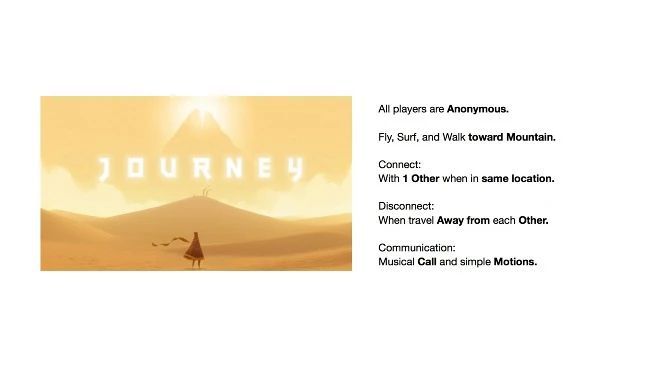
All Players are Anonymous
兩位玩家都是匿名的
Fly, Surf and Walk forward Mountains
共同朝著山飛翔、滑行、行走
Connect:With 1 Other when in same location
和一位同時處在相同區域的玩家連線
Disconnect:When travel Away from each Other
當遠離了另一位玩家
Communication:Musical Call and Simple Motions
樂音式的呼喚和簡單的動態
【以上為幻燈片文字翻譯】
You may have heard of Journey. For those that don’t know, Journey is an online game where anonymous players walk, surf, and fly toward a Mountain—and can connect with 1 player at a time in the process. Connections occur when two players are in the same part of the world. If the two players move far enough apart, they are disconnected. Players can’t talk or type, instead they communicate through a musical call and the simple motions of their characters.
你可能聽說過《風之旅人》。如果你沒聽說過,《風之旅人》是一個聯網遊戲,在遊戲中,匿名的玩家們朝向著一座山行走,滑行,與飛翔。每次這個過程中可以與一個玩家相連線。當兩個玩家處於世界的同一地區時,就會發生連線。而如果兩個玩家之間的距離太遠,連線就會斷開。玩家不能說話或打字,而是通過音樂性的呼喊和他們角色的簡單動作進行交流。
I’d like to briefly mention that I wasn’t on Journey for the first half of its development. That time was spent developing WAY. And so I’ll speak specifically on Journey as we developed it in the last 15 months.
我想簡單提一下,在《風之旅人》開發的前半段,我並沒有參與其中。那段時間我在開發《WAY》。因此,我將具體談談我們過去15個月裡開發的《風之旅人》。
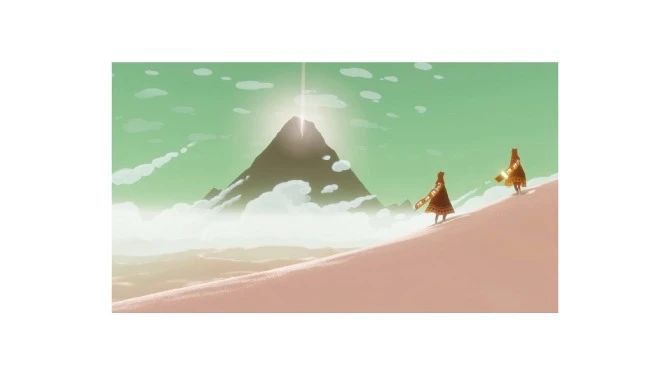
One of the focal questions of Journey is "What if...in a game about discovery and transformation, you experience that transformation alongside another?"
《風之旅人》的核心問題之一是「如果在一個關於發現和轉變的遊戲中,你與另一個人一起經歷了這種轉變,會怎麼樣?」
What will you feel?
你會有什麼感覺?
Will you feel connected?
你會感覺到被連線嗎?
Like many linear games and other classic stories, Journey borrows the structure of the monomyth—a transformation story. Emotions arc as the protagonist passes from experience to experience. Because you engage in these experiences with another player, there is the potential to share a wide range of emotions with them.
就像許多線性遊戲和其他經典故事一樣,《風之旅人》借用了英雄之旅的結構——一個「轉變」的故事。隨著主人公經歷了事物,情緒便產生了弧光(發生變化)。而你與另一個玩家一起經歷了這些體驗,所以有可能與其分享這些豐富的情感。
Now because there’s no textual or verbal communication in Journey, it’s impossible to know exactly what the other player is feeling or thinking. Personally, I find that beautiful. After all, no two persons in this room could ever know exactly how each other feels—we are creatures of interpretation—each with our own perspective. Like the dead corpse in Final Fantasy XI, without words, the player is able to project their own thoughts onto the other person and what they think the other person is thinking...generating perceived empathy.
正是因為《風之旅人》中沒有文字或語言交流,所以不可能確切地知道其他玩家的感受或想法。就我個人而言,我覺得這很美。畢竟,在這個房間裡沒有任何兩個人能夠確切地知道對方的感受--我們是解釋性的動物,每個人都有自己的視角。就像《最終幻想11》中死去玩家的屍體一樣,在沒有語言的情況下,玩家能夠將自己的想法投射到對方身上,並去思索他所認為對方在想什麼的事情......這產生了可感知的共情。

This is true not only of a moment of discovery, but also when players choose to walk away from each other. When two players separate, they disconnect. Why did that person leave? Did they not want to travel with me? Were they distracted by something? Should I follow? These are all questions. You wonder about them because you don’t know for sure.
這不僅適用於共同探索的時刻,也適用於玩家選擇離開對方的時候。當兩個玩家分開時,他們斷開了聯絡。那個人為什麼離開?他/她不想和我一起旅行嗎?他/她是被什麼其他東西分心了嗎?我應該跟著他/她嗎?這些都是問題。你想知道答案,正因為你無法確知。
When players disconnect, they disappear from the world. Because the world of Journey has many large and barren vistas, players feel small and lonely. Because it’s barren, this also means that when another player appears and moves through the landscape they become a focus.
當玩家斷開連線時,他們從世界中消失。因為《風之旅人》的世界有許多巨大而荒蕪的遠景,玩家會感到自身的渺小和孤獨。因為它是荒蕪的,這也意味著當另一個玩家出現並在地形中移動時,他們會成為焦點。
Journey also maintains the important 4th wall. Though one might argue text and speech allow players to more clearly discuss or rejoice over a particular event...text and speech also introduce a number of unwanted verbs that could break the experience. Players could be pulled out, the game could become an object for discussion versus the world that simply is, etc.
《風之旅人》維持了重要的第四面牆。有人可能會說,文字和語音可以讓玩家對某一特定事件更清晰地討論或為之歡欣鼓舞......但文字和語音也引入了一些不必要的動詞,而這可能會破壞體驗。玩家可能會因此抽離出來,遊戲本身可能成為討論的物件,而不再是一個簡單的世界,等等。
Personally, I prefer that players communicate through nonverbal actions. This places everyone on a more even ground—any two players have the same actionable verbs.
就個人而言,我更喜歡玩家們通過「非語言行為 nonverbal actions」交流。這使每個人都處於更平等的地位——任何兩個玩家都有相同的「可執行動詞」【例如在遊戲空間中移動,行走,發出音樂性的呼喚等等】。
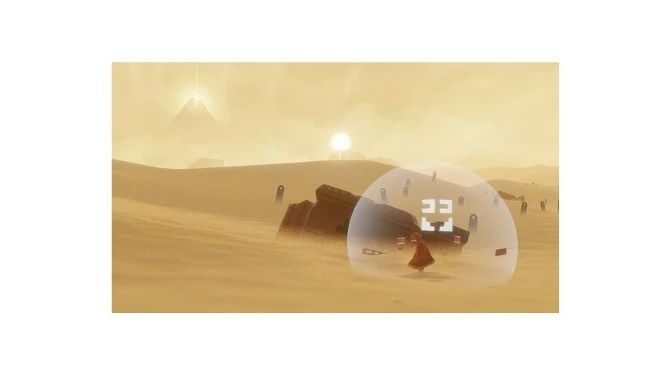

In Journey, one of the clearest examples of these is the players’ musical call. The call serves a number of functions—one of which is to get the attention of the other player. Though it’s a single button, the call has a range of expression—and this is important. Tap the call in quick succession and it may resemble excitement. Hold the call button down for a longer period, and the character releases a more powerful shout. How players call helps bring identity to their person.
在《風之旅人》中,最明顯的例子之一是玩家的音樂性的呼喊。呼喊有許多功能,其中之一是引起其他玩家的注意。雖然它是個單鍵,但卻能有一定範圍表達的可能——這很重要。快速連續點選,這可能類似於表達興奮。長時間按住呼喊的按鈕,角色就會發出更有力的呼喊。玩家進行呼喚的方式有助於建立他/她的身份特性。
I spent many hours playtesting with my teammates at thatgamecompany, and I could often tell one person from another just by how they used their calls to express themselves. Like any strong relationship—it requires the other person has a unique, personal, human identity for you to resonate with.
我和我在thatgamecompany的同事花了很多時間進行了遊戲測試,我經常可以僅僅通過他們使用呼喊功能來表達的方式來區分他們。就像任何牢固的關係一樣——它要求對方有一個獨特的、個人的、人類的身份特徵,以令你能產生共鳴。
We can remove text and speech, but we must not remove the player’s voice— their ability to express emotions, feelings, and opinions.
我們可以拿掉文字和語音,但我們不能拿去玩家的聲音-表達(voice)——他們表達情緒、感受和觀點的能力。
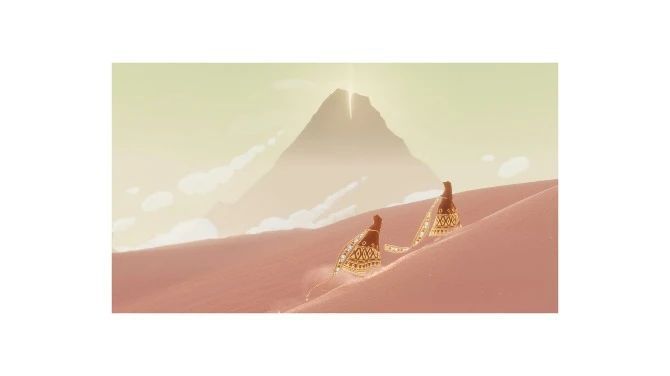
The call provides other functions. Players can “harmonize” with other players in the world— glowing the players and giving each other expendable energy with which they fly. Players can obtain this resource by physically touching each other—encouraging them to stay close, again bonding them—or by calling to each other within the radius of the bubble created by the call. The shared dynamic this creates is that of a Call & Response.
這個呼喊技能也有其他的功能。玩家可以與世界上的其他玩家 "諧調 Harmonize"——讓玩家角色發光,並會給對方提供可供飛行的消耗效能量。玩家可以通過角色的身體接觸來獲得這種能量資源——這鼓勵他們待在一塊、連線,或者在呼叫所產生的氣泡半徑內相互照應。這創造出的共享的動態是一種「呼喚和回應 Call & Response」。

I call to you, you fly and expel your resource, you call to me, and I fly and expel mine. This creates a rhythm between the players. I personally like to think of it like a dance, or perhaps a version of Leapfrog. This is an example of Reciprocity, equal give and take between both parties. Reciprocity is a fundamental characteristic of friendship.
我呼喚你,你就飛起來,釋放出你的能量;然後你呼喚我,我飛起來,釋放出我的能量。這在玩家之間創造了某種節奏。我喜歡把它想成是某種舞蹈,或者是某種版本的跳背遊戲(Leapfrog)。這是一個「互惠(Reciprocity)」的例子,雙方之間平等地給予和接受。互惠是友誼的一個基本特徵。
Without the other person around, players are unable to continually fly. And so when they’re gone...or when they choose not to help...you can feel that. You feel it in the slow walk, your progress hampered, though not obstructed. This is us designing for a feeling of Longing.
沒有其他人在身邊,玩家就無法持久地飛翔。當他/她離開......或者當他/她選擇不幫助時......你可以體會到它。你可以在緩慢的行走中感受到它,你的前進受到了阻礙,儘管沒有受到阻撓。這是我們所希望設計出的某種渴望的感覺。
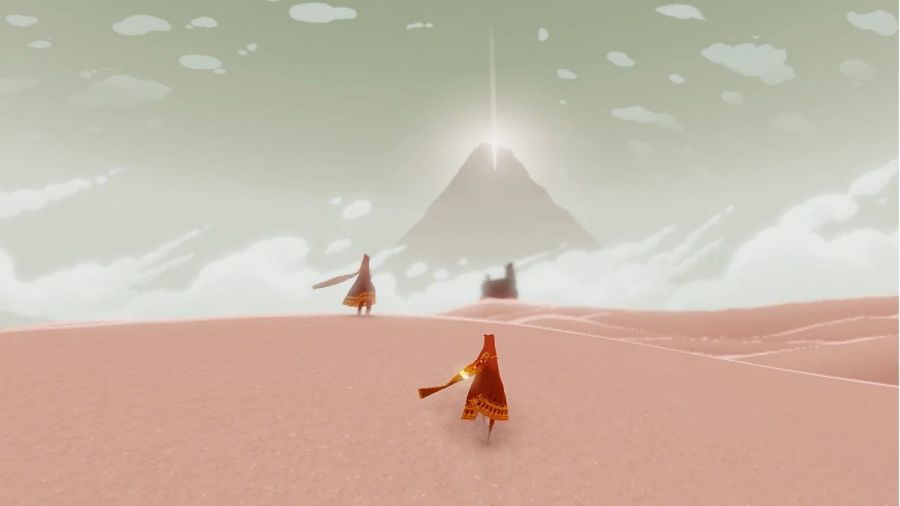
Together we fly toward a single shared goal—the Mountaintop—which funnels the players together.
我們一起朝著一個共同的目標飛去——山頂,而這將玩家吸引到一起。
Replayability often comes up in critiques of Journey. One of the questions we find interesting is, once the endpoint has been reached and the story completed—once the discoveries of the world have been revealed to the player—what becomes important then? What does it mean to play the game a 2nd, 3rd, 5th or hundredth time? Where will players find value then? And what about years from now, when the deserts are barren and there’s rarely a journeyer walking to the Mountain? What will it mean to suddenly find another person in the dunes?
可重玩性常出現在對《風之旅人》的評論中。我們發現一個有趣的問題便是,一旦到達終點,故事完成,一旦世界已經完全展現在玩家面前後——什麼變得重要了?第二次、第三次、第五次或第一百次玩這個遊戲意味著什麼?那時,玩家將在何處找到價值?而多年以後,當沙漠荒蕪,很少再有旅行者往山的方向走去時?突然在沙丘上發現了另一個人意味著什麼?
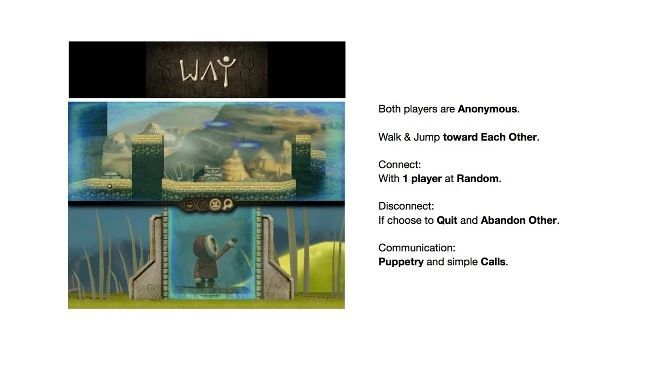
Both Players are Anonymous
兩位玩家都是匿名的
Walk & Jumps toward Each Other
互相朝著對方走/跳去
Connect:With 1 Player at Random
和一位隨機的玩家連線
Disconnect:If choose to Quit and Abandon Other.
如果選擇退出並拋棄另一位玩家則失去連線
Communication:Puppetry and Simple Calls
溝通:提線木偶演出和簡單的呼喊
【以上為幻燈片文字翻譯】
Before working on Journey, I spent 12 weeks designing the shortform version of WAY with a small team. It was made without any preexisting knowledge of Journey, mostly designed before Journey was even announced—and yet there are quite a few similarities. In our attempts to form connections between strangers, both designs arrived at similar conclusions—and yet they are two very different games. Each with a very different set of aesthetics and design philosophy.
在製作《風之旅人》之前,我和一個小團隊花了12周時間設計《WAY》的短篇版本。它是在對《風之旅人》沒有任何預先了解的情況下製作的,大部分是在《風之旅人》正式宣佈之前設計的——而它們之間有許多的相似之處。在在陌生人之間形成聯絡的嘗試過程中,兩個設計都得出了類似的結論——然而它們是兩個非常不同的遊戲。各自有一套非常不同的美學和設計哲學。
WAY is a communication puzzle-platformer. In WAY, you and an anonymous player venture toward each other from opposite ends of the world, solving the puzzles between you. The game is played in split-screen, and each player sees the world differently. One player will have information the other does not—such as the location of an invisible platform where they need to jump, or perhaps a trap they need to avoid—and so you need to communicate this information with each other to progress. Like Journey, there is no text or speech communication. Instead, players have to share information by puppeteering their avatars. You can point, wave, mime a circle, nod your head—whatever works for you in the system. All of these are player controlled—ensuring the puppetry is a manifestation of your specific voice.
《WAY》是一款強調交流的平臺解謎遊戲。在《WAY》中,你和一個匿名玩家從世界的兩端向對方的方向進行冒險,解決在你們之間的謎題。遊戲以分屏方式進行,每個玩家看到的是不同的世界。一個玩家會有另一個玩家沒有的資訊——比如他們需要跳上的隱形平臺位置,或者他們需要避開的陷阱——因此你們需要相互交流這些資訊來前行。與《風之旅人》一樣,沒有文字或語音的交流。作為替代,玩家必須通過如同木偶戲式地操作(puppeteering )他們的遊戲角色來分享資訊。你可以指向、揮手、劃個圈,點點頭——任何在系統中對你有用的方式。所有這些都由玩家控制——確保這種木偶式的操作能成為一種你特有的表達方式(manifestation of voice)。
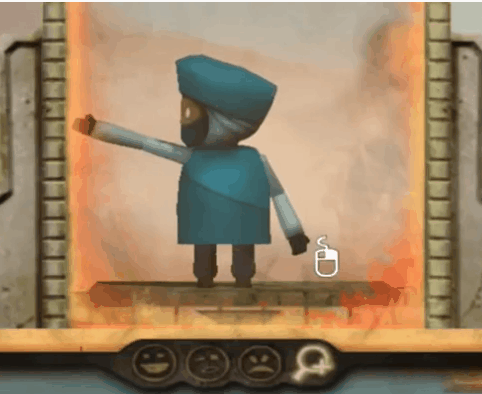
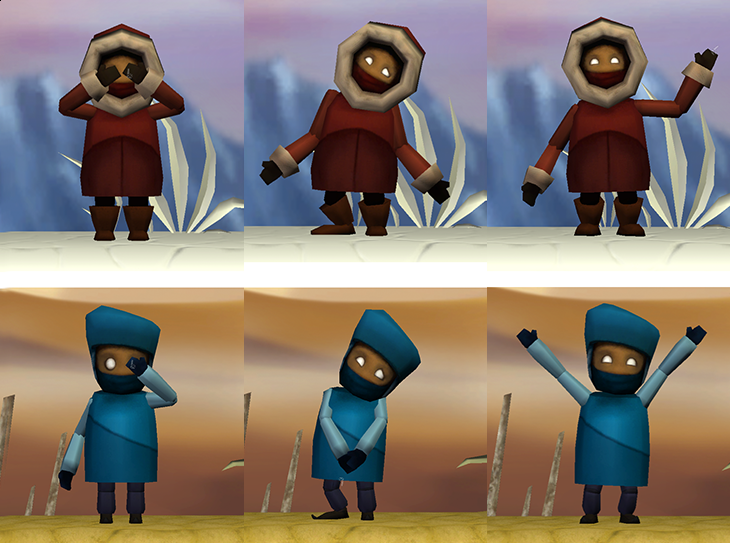
Because play is anonymous, players cannot use third-party chat clients like Ventrilo or IM to break the 4th wall.
由於遊戲是匿名的,玩家不能使用如Ventrilo(Voice over IP (VoIP) group communications software)或IM(即時通訊 Instant messaging)的第三方聊天客戶端來打破第四面牆。
When the game starts you are alone. It’s not until you proceed a bit further that your world splits in two and the other person appears. This creates a sense of surprise. The other person, like in Journey, is a discovery...an epiphany—and it’s this realization of the Other that grabs your focus.
遊戲開始時,你是一個人。你繼續前進,你的世界開始一分為二,而另一個人出現。這創造了某種種驚喜。另一個人,就像在《風之旅人》中一樣,是一次發現,一個對事物真諦的領悟——正是這種對「他者」的意識吸引了你的注意力。
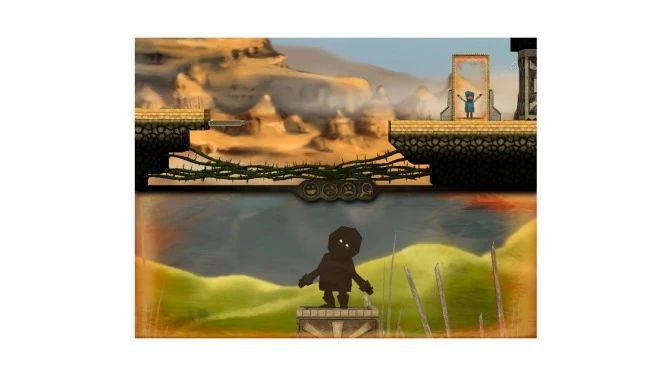
—
Little is explained within the game world, empowering the players to become teachers unto each other. Rather than teach the players ourselves, we instead empart as much of that responsibility to the player. This encourages players to speak to each other and creates opportunities for a stronger connection.
遊戲世界中幾乎沒有任何解釋,這使得玩家去成為彼此的老師。與其說是我們自己教玩家,不如說我們將這個責任儘量交給玩家。這鼓勵了玩家互相交流,並創造了加強聯絡的機會。
When 1 player understands and does not teach it to the other—it can lead to failure and frustration—but this too can be positive! We’ve seen players suddenly realize they had information the other did not, and then feel shame for not helping each other. If this occurred outside the game, we would hope that person reflects on not helping when they could have.
當一個玩家理解了,但卻沒有教給另一位玩家的話,那可能會導致失敗和受挫,但這也可以是積極的!我們看到過玩家突然意識到他/她有對方所沒有的資訊,併為沒有能幫助對方而感到羞愧。如果這種情況發生在遊戲之外,我們也會希望那個人會反思他自己在他/她本可以幫忙的時候卻沒有伸出援手。
That is something we value.
這是我們所重視的。
Because neither player has all of the information, players are interdependent. This is a big difference from Journey. Each player needs the other. In order to finish the game, you must invest yourself and commit to playing with this single other person.
因為雙方都沒有能掌握所有的資訊,所以玩家們是相互依賴的。這與《風之旅人》有很大不同。每個玩家都需要對方。為了通關遊戲,你必須投入自己,去與那位陌生人一起去玩。

Portal 2 multiplayer has something similar, but it's not quite the same for an important reason. I am a fan of Portal 2, but there are certain rules in the puzzle design that WAY approaches differently.
《傳送門2》的多人遊戲也有類似的東西,但由於某個重要的原因,結果卻不太一樣。我是《傳送門2》的粉絲,但它在謎題設計上有某些特定的規則,與《WAY》的做法 是不同的。
In Portal 2 multiplayer, it’s common for one player to understand the full solution of a puzzle. Once that is understood, the player simply need tell their partner what to do. This can lead to a sort of single-player domination effect where one player is solving the puzzle and the other is simply following orders. Because orders in Portal 2 are easily understood, because orders are not designed to be puzzling—I tag a wall with a cursor of a portal, you place a portal on that cursor—the puzzle need only be solved by one person.
在《傳送門2》的多人遊戲中,通常是其中一個玩家來理解謎題的全部解法。一旦理解了,這個玩家只需要告訴他的夥伴該怎麼做。而這可能會導致一種單一玩家支配效應(single-player domination effect),即一個玩家在解謎,另一個玩家只需要聽從指示。因為《傳送門2》中的指示很容易理解,指示並不是解謎的一部分——我在牆上放一個傳送門的標記,你就在這個標記上放置一個傳送門——所以謎題只需要一個人來解決。
This can lead to a scramble effect, where players are trying to solve the puzzle faster than each other—and that can result in a feeling of spite if your partner solves it before you. I haven’t asked, but I wonder if this was the feeling they were going for. Another result of that same scenario is one player stops trying to solve puzzles entirely, and simply waits for the other to figure it out.
這可能會導致某種爭奪效應(scramble effect),即玩家試圖比對方更快地解開謎題——如果你的夥伴比你先解開,這可能會導致某種怨恨感。我沒有問過,但我想知道這是否是他們所追求的體驗。同樣情形的另一個結果是,一個玩家完全不再嘗試解謎,而只是等著另一個玩家想出解法。

Because communication in WAY is interdependent, one player communicates while the other player actively listens, and vice versa—both are engaged and equally important. This creates a shared Call & Response dynamic—somewhat comparable to the call & response in Journey where players take turns sharing the resource to fly.
因為《WAY》中的交流是相互依賴的,一個玩家在交流,同時另一個玩家在積極傾聽,反之亦然——雙方都在參與,而且同等重要。這就創造了一種分享的「呼喚-回應」的動態——有點類似於《風之旅人》中輪流分享能量進行飛行的呼喚與回應。
In WAY, meaning is constructed from a freeform puppet system. The players create their language, freely choosing what means what. This ensures that whatever players come up with— however they solve the puzzle—is their own. We’ve actually seen players discover entirely valid solutions that we the designers did not even consider.
在《WAY》中,意義是由一個形式自由的木偶動作系統所構建的。玩家創造他們的語言,自由選擇特定的動作來表達特定的意圖。這確保了無論玩家想出的什麼東西——無論他們如何解決這個謎題——都是他們獨有的。我們實際上已經看到玩家探索出了完全可行的,而我們這些設計師卻甚至從來沒想到過的解法。
And there’s another win here too. Because puzzles are open-ended—because players create their own language to solve each problem—solutions can feel both smooth or clunky. This too is part of WAY’s philosophy. Group A might arrive at a transparent solution to a puzzle and it feels graceful, while Group B comes up with a convoluted one and it fails and fails until it finally works. Group B might walk away from that experience saying “oh that was horrible” or “how sloppy”—but I find that to be honest design.
而這也是另一種成功。因為謎題是開放式(open-ended)的——因為玩家創造了他們自己的語言來解決每個問題——所以解法可以感覺很順暢,也可能很笨拙。這也是《WAY》哲學的一部分。A組可能會得出一個清晰、優雅的謎題解法,而B組則可能會想出了一個極度複雜的解法,並在最後成功之前不斷失敗。B組可能會說 "哦,這太可怕了 "或者 "太亂了",但我認為這才是誠實的設計。
That’s how the world works.
這就是世界的運作方式。
They didn’t consider an alternative.
他們沒有考慮其他的選擇。
And then we’ve seen these players revisit those puzzles with a new partner who then shows them another way. And suddenly their perception grows.
然後我們看到這些玩家和一個新夥伴一起重溫了這些謎題,而這個新夥伴又給他們展示了另一種解法。然後突然間他們的認知就增長了。
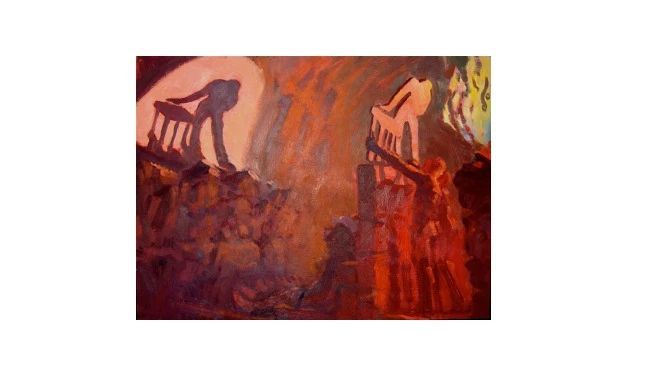
As a metaphor, consider talking to your friend and describing something they have never seen. How you explain what you mean will determine whether or not your friend understands you. Depending on the approach, coming to an understanding could be simple or difficult. So is true in WAY.
作一個比喻,想象你與你的朋友交談,描述他/她從未見過的東西。你如何解釋將決定你的朋友是否理解。這取決於不同方法,達成理解可能很簡單,也可能很困難。在《WAY》中也是如此。
And in a game about communication, should we or shouldn’t we be teaching players to value how they communicate?
在一個關於溝通的遊戲中,我們是否應該引導玩家去重視他們溝通的方式?
In the pamphlet I mention that I’d also talk about how we “maintain” these friendships. Both of these games attempt to establish a bond, but what it takes to carry a friendship forward...to transcend and become something bigger than the game...requires growing beyond the game itself.
在小冊子中提到的,我還希望談論我們如何 「維持」 這些友誼。這兩個遊戲(《WAY》和《風之旅人》)都試圖建立一種紐帶,但將友誼向前推進......超越併成為比遊戲更大的東西......我們需要超越遊戲本身的發展。
Within these controlled systems like WAY and Journey, it’s impossible to include so many of the things that might strengthen the bond between two persons. And so instead, we focus on establishing the connection. Then, upon completion, each game provides an invitation to carry that bond forward. The design for these invitations is very different in each game.
在《WAY》和《Journey》這些受控系統(controlled systems)中,不可能去包括這麼多可能加強兩個人之間聯絡的東西。因此相反,我們專注於建立這種聯絡。然後,在完成之後,遊戲都提供了某種「邀請」,以使這種聯絡能繼續下去。這種「邀請」的設計在每個遊戲中都非常不同。
If it’s your intention to allow players to grow their bond beyond the game, you’ll need to eventually release them from the cave and relinquish your control as designer.
如果你的意圖是讓玩家在遊戲之外發展他們的聯絡,那你最終需要放棄你作為設計師的控制權,把他們從洞穴中釋放出來。
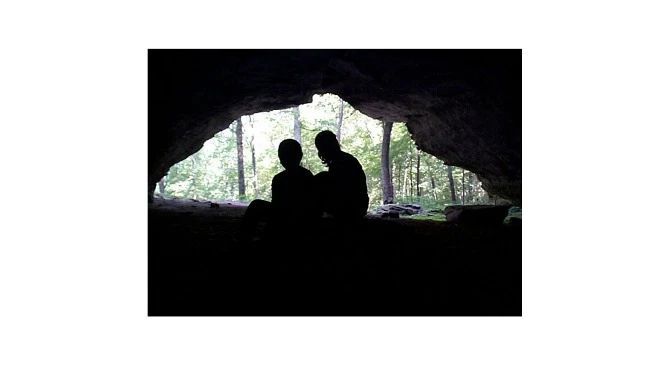
I’m going to reserve discussing the ending of WAY specifically. Instead, I’d like to share one last personal story that speaks to its spirit.
我將保留對《WAY》結局的具體討論。相反,我最後想分享一個我個人的故事,以說明其精神。
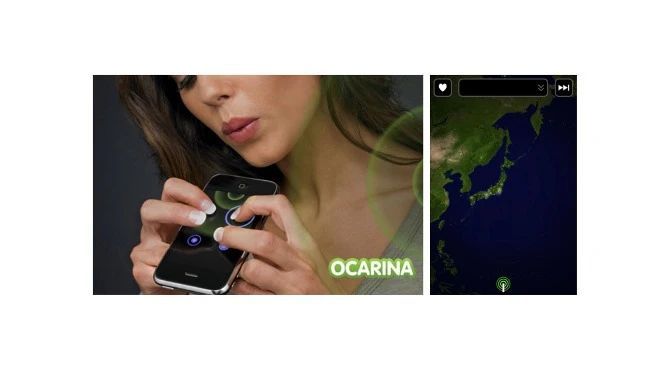
For those of you that aren’t familiar, the iPhone app Ocarina transforms the iPhone into an ocarina. Hold down keys and blow into the microphone to make different notes.
對於那些不熟悉的人來說,iPhone應用程式Ocarina將iPhone變成了一個陶笛。按住按鍵,對著麥克風吹氣,就能發出不同的音符。
I’m a big fan of this app, and I use it in a very specific way. There is a feature in Ocarina that allows you to listen to people play as they stream their music live. Whenever there is a big event in the world, I like to open the app and listen to the songs being played there.
我是這個應用程式的忠實粉絲,而且我以一種非常特殊的方式使用它。Ocarina有一個功能,可以讓你聽人們直播他們的音樂演奏。每當世界上某處發生了大事,我總喜歡開啟這個應用程式,聽聽那裡的人彈奏的歌曲。
The day after the Tsunami hit Japan, I touched my finger over the eastern coast and waited for notes. I wasn’t sure any would come.
在日本發生海嘯【譯註:這裡應是指2011年3月11日14:46:21在日本東北部太平洋海域發生的東日本大地震】的第二天,我用手指在日本東海岸的位置上觸控,等待著音符。我不確定是否會有任何音符會出現。
The song that came was “Ode to Joy”.
出現的歌曲是《歡樂頌》。
Those notes stunned me, and they stun me still. I immediately envisioned that person sitting amidst a horizon of rubble. I couldn’t process what they must be feeling, but I desperately wanted to send notes back.
這些音符震撼了我,時至今日。我當時立刻想到那個人坐在一片瓦礫中的情景。我無法完全地領會他/她的感覺,但我迫切地想把以音符去回應他/她。
I couldn’t.
我做不到。
That wasn’t part of the design.
這不是設計的一部分。
As architects of games, we have full control over what is valued. If the world isn’t valuing what we consider significant, we have the responsibility to create worlds that do.
作為遊戲的設計師,我們對遊戲中「何為價值( what is valued)」能有完全的掌控。如果這個遊戲世界並不重視(value)我們認為重要的東西,那我們有責任去創造一個讓他們重視的世界。
Our medium is Play, an instinctual language of action that reaches across all cultures.
我們的媒介是遊戲,一種能跨越所有文化的本能的行動語言。
And aren’t actions what’s important?
而行動不正是那重要之事?
What I will say concerning the ending of WAY is that players have the choice to do something.
在《WAY》的結局,玩家可以選擇做一些事情。
It’s what you choose to do that reveals who you are.
而你所選擇做的揭示了你是誰。
Thank You."
謝謝。"
譯者補充
上文 you’ll need to eventually release them from the cave and relinquish your control as designer 中洞穴的比喻特別好,這裡的cave指的正是在《WAY》和《Journey》的設計中玩家無法用言語和文字交流,並且一同穿過黑暗的冒險。
其中所說的「邀請 invitation」,在Journey中呈現為一片雪地,許多玩家在最後通關前都會在這篇雪地上走出愛心的形狀對同伴表達自己的感謝與情意,在網上能夠找到許多人分享的經歷。
我會想起當時遊戲主創陳星漢在另一個GDC Talk(這個內容@李姬韌在2014年已經有過翻譯《<風之旅人>設計師分享團隊開發遊戲的過程》)中提到的兩件事:
一件事是關於遊戲內,設計師所限定的表達手段而可能造成的表達效果,從這個角度可以理解為何今天的大部分遊戲是關於戰鬥與暴力的:
我們增加了玩家之間的物理特性,使得他們可以互相推,能夠感覺到對方的存在。這非常棒。 但是,玩家們所做的,並不是把對方推過岩石,而是把他們推向一些更奇特的東西(仙人掌)。
有很長一段時間。我覺得是因為這些玩家玩了太多的使命召喚,他們變得這麼險惡了。但後來,我們在自己辦公室做測試,我們的主程式,把我推到障礙物上殺掉了,很多次。我問他,你知道這個遊戲是關於幫助他人和建立情感連結的對吧?為什麼你總是在這樣做?他只是看著我,大笑,因為我們就在辦公室兩端,他說:快復活(再來一次?)。然後我意識到,有好長一段時間,我對人性感到失望。
有一天朋友介紹我建了一個心理諮詢師。我就和她談了人性的這種困境。她說,因為他們是玩家。他們是嬰兒。什麼意思呢?當你把你自己從現實世界代入到一個虛擬空間中,特別是一個角色長的像成年人的虛擬空間,你不再保持現實世界中的那些道德規範了。你就像一個嬰兒。嬰兒只追求反饋。把一個人推上岩石沒有任何反饋,但把一個人推死,會有動畫,有血,有哭喊的聲音,有一股壓抑著的社交焦慮等待你去復活你的人物。這更多是關於回饋的。當然玩家想要做有更多回饋的事情。所以我學到了,道德並沒有代入到虛擬世界中,為了控制玩家的行為,你要控制輸入和輸出。
為了避免這種情況發生,我們最終放棄了碰撞的設計。為了取代互相推的玩法,我們設計了替代機制:當兩個人站在一起,就會給對方能量。所以玩家們就喜歡在一起,因為有很多反饋,而無法從把隊友推下懸崖中獲得反饋。現在他們共同飛起來了,而且始終保持在一起,愛對方。
第二件是關於這類遊戲的匿名性,這種匿名性所造成的的是某種情感的投射與想象,是某種混合著本就無法跨越的美好的誤解,其中合適的一個距離反而成了美。
陳星漢在GDC上提到他收到了八百多封的來信,來自世界各地的玩家談論他們遊玩《風之旅人》的經歷,他分享了其中的一封:
你的遊戲確實改變的我的生命。這是我和他一起最大的快樂,自從他被確診以後 ......我爸爸,2012年春天過世了,在確診之後僅僅幾個月。
他過世幾周後,我終於能夠讓自己走出來一些,自己玩遊戲。我試著玩《旅》,我看到那開始畫面,就大哭起來。
在我和我爸爸玩《旅》的過程中,我發現這正是關於他,和他走向人生終點的旅程。我相信我和我爸爸在最完美的時機遇到了你的遊戲。
我想感謝你,因為你的遊戲改變了我的生命。它的美麗讓淚水盈滿我的眼眶。《旅》很可能是我玩過最好的遊戲。
我持續的玩,一直記著它所帶給過我的快樂,和它將持續帶給我的快樂。
我叫索菲亞,我15歲,你的遊戲讓我的生命更美好。
而由於《WAY》的版本年代久遠(2011),我嘗試過了許多次都無法進行聯網,所以選擇了看通關視訊,在遊戲最後場景,玩家從世界的兩端最終走到了一起而相遇,玩家坐上了一個上升平臺,出現credits:

玩家會來到了一個巨大的繪製有世界地圖的石牆前,玩家可以踩住機關並且在石牆上寫字與繪製箭頭,突然間,語言和直接的表達變得如此可貴,在我看的這個視訊中,紅色玩家激動地寫下了Hello,並且在地圖上圈出了一個地方,寫道:
"I'm here!"
“我在這裡!”

作者:Chris Bell
翻譯:DeepL
校對潤色、幻燈片翻譯、圖片補充:葉梓濤
來源:落日間
地址:https://mp.weixin.qq.com/s/hLKsZvM-_nmIipw7pibiFA
相關文章
- 幾種著名的戰略思想設計工具介紹 - Chris
- 面向方面程式設計的Annotation簡介(轉)程式設計
- 天才程式設計師 Fabrice Bellard程式設計師
- 面向方面程式設計的介紹----基本概念(1) (轉)程式設計
- AOP 面向方面程式設計的介紹----基本概念(2) (轉)程式設計
- AOP 面向方面程式設計的介紹----基本概念(3) (轉)程式設計
- PHP 的面向方面程式設計PHP程式設計
- Swift 面向協議程式設計 基礎篇 (一) 介紹Swift協議程式設計
- 面向介面程式設計程式設計
- 程式設計思想 面向切面程式設計程式設計
- 面向資料的程式設計 · Laurent程式設計
- 面向sql程式設計的探索之路SQL程式設計
- 面向魯棒的系統設計
- AOP 面向切面程式設計程式設計
- 面向架構程式設計架構程式設計
- AOP(面向切面程式設計)程式設計
- 面向協議程式設計協議程式設計
- 面向切面程式設計AOP程式設計
- 面向方面的程式設計程式設計
- 面向指標程式設計指標程式設計
- 設計模式之面向切面程式設計AOP設計模式程式設計
- Android AOP面向切面設計程式設計Android程式設計
- aop面向切面程式設計的實現程式設計
- Java中的面向切面程式設計(AOP)Java程式設計
- 面向演算法的架構設計演算法架構
- Swift中的面向協議程式設計Swift協議程式設計
- 面向JavaScript的SOLID設計原則JavaScriptSolid
- 面向.Net程式設計師的dump分析程式設計師
- Avalon:面向元件的程式設計(COP) (轉)元件程式設計
- 張曄:面向統計研究的R程式設計程式設計
- 翻譯:Swift 5.1中的Protocol面向協議的程式設計教程:從入門到精通SwiftProtocol協議程式設計
- 面向介面的程式設計+MVC程式設計MVC
- Java 面向切面程式設計AOPJava程式設計
- 面向介面程式設計把握不好程式設計
- AOP--面向切面程式設計程式設計
- DirectShow應用程式設計介紹(翻譯) (轉)程式設計
- Swift 面向協議程式設計的那些事Swift協議程式設計
- 面向切面程式設計之瘋狂的 Aspects程式設計